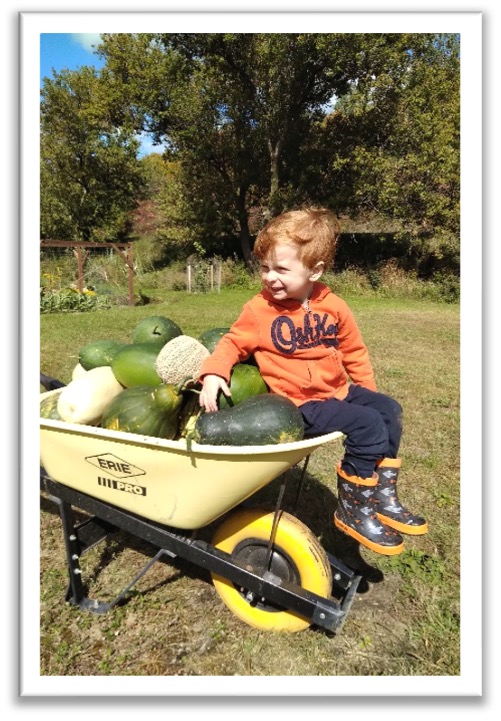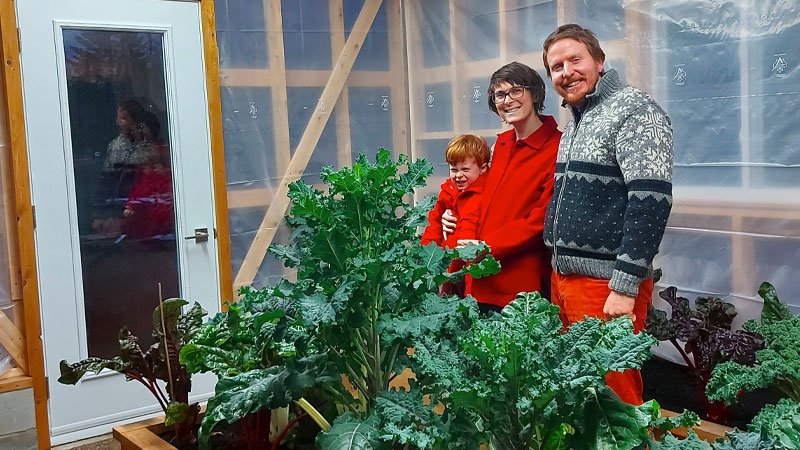A Quebec Family Analyses a Year of Data
How much work does it take to grow most of the produce our Quebec family eats in a year? How much does it cost, and how much space do we need?
These are the questions we set out to answer in 2021. We have been subsistence gardeners for several years now; mostly in coastal BC (Plant Hardiness Zone 8), but for the last 3 years in the Gatineau Hills of Quebec (Plant Hardiness Zone 4). In the summer of 2020, we even built a small permanent greenhouse that could be heated in winter, allowing us to grow year-round. While our fruit orchard is still quite young, our garden now fulfills at least 90 percent of our produce needs for the year. We eat what we grow, and we grow what we eat! It’s a deceptively simple plan, which we tweak from year to year as our young family grows, our food preferences change, our knowledge deepens and our skills sharpen.
The only way to keep track of it all, of course, is to keep good records! We take note of all the important information from year to year: seeding and planting logs, hard frost dates and extreme heat waves, bug infestations, complete harvest records for our crops, yearly garden maps, successes and failures, notes for the following season, and anything else worth noting. We also take pictures of our gardens at different times for a visual reference, making it easy to compare from year to year what certain plantings actually looked like at similar times.
It might sound like a lot of work, but it’s really only a few handwritten notes in a cheap notebook, and a few pictures in our smartphones; nothing too complex. And believe me, any effort spent here saves us in multiples when winter rolls around and we start eagerly planning our next growing season. “When did we plant those carrots last spring? How many kales did we end up planting? Where was the garlic planted two years ago? How many watermelons did we get last summer? When was the last frost in the spring?” Good luck remembering all that!
Just about the only thing we haven’t kept track of is our labour. Then again, why would we? Nowadays, when you decide to grow food, it’s usually because you want to. Like any other ‘hobby’, the last thing on your mind is how many minutes you’re going to spend doing it. Keeping spreadsheets on labour data is probably as diametrically opposed to getting your hands in the dirt as you’re likely to get. Neither would it add value to what we do… or would it?
We grow all of our food in three distinct areas, which we label as follows: The Garden, The Greenhouse and The River Beds (named for their proximity to the river). The garden is the largest by far, with a footprint of 30 feet by 60 feet. Our small greenhouse has a footprint of 12 by 15 feet (the maximum allowed by the municipality), and the two river beds have a combined surface of 4 by 20 feet. Our growing spaces are inefficient by professional standards; the walking paths are too wide and numerous, but this was by design for comfort and ease of circulation (good for kids to run around in!). Despite this, let us keep to these numbers and assume our total food production footprint is around 2060 square feet, or about 1/20th of an acre. In a good year, that is just enough space to provide us with all the produce we need, plus some to share. In a year like 2021, suffering through several modern-day biblical plagues (wait – does climate change count?), it falls a little short of 100 percent, but still gets us by.
Our property is right off the main road in our rural community. Everybody drives by it at some point. It’s a nice piece of land and the road is several feet higher than us, so the vantage point as you drive by affords a good overview of our property. With our garden being relatively large (for a home garden), and the infrastructure being rather unusual for the area, we get a fair number of comments from onlookers. “Nice garden! I love driving by it on my way to work every morning.” That sort of thing. It’s always positive feedback, which is lovely, but quite often it’s accompanied with some sort of remark about the ‘work’ we put into it, like: “I love your garden! It must be a ton of work though, eh?” Or, “I always see you out there when I drive by; you two put so much work into your gardening!”.
My typical response was: “Actually, it’s really not that much work…”. Truly, other than the initial time spent on the infrastructure (fencing, greenhouse, etc.) and the odd calamity, the gardening itself is mostly undemanding. To be honest, I almost took exception to those comments. It’s as if they were saying “You’re crazy for doing all that.” A part of me always wanted to ‘prove’ that what we’re doing isn’t actually hard, and achievable by anybody who cared to try. In fact, I always thought that if you averaged it out for the whole year, it would probably only represent about 15-20 minutes of work per day. Certainly, less involvement than owning a medium-size dog anyways. Alas, there was no way for me to prove it…even to myself. Was I wrong? Were we blinded to reality by a thick veil of bucolic ideals? It would be worth looking into.
Why not do it then? Why not record all of our food production labour for a year? If we did, we’d know exactly what our ‘average daily input’ is. Not only that, but this new data set, in conjunction with the others, would allow us to ascribe a certain value to our labour, like an hourly rate. This prospect was also quite interesting to me. I was curious because in general, the assumption with farmers and growers alike is that if they ever figured out the ‘wage’ they were earning, it would be abysmally low (lots of work, low pay). After all, no one goes into farming for the money. As the old joke goes, “How does a farmer make a million dollars? He starts with two million!”
Thus began the year of spreadsheets! We printed sheets for every month of the year, and kept track of every minute we spent doing a variety of tasks, which we grouped into 5 separate categories: Prepping/Planting, Watering, Garden Management, Harvesting and Processing. See the table below for descriptions.

A note on precision: While we strived to measure our time as accurately as possible, many tasks are repetitive (think watering) so we averaged and rounded when acceptable to do so. Moreover, the accuracy of the numbers is not really paramount. The nature of gardening itself guarantees that this will always be a moving target. The size of the garden, the plants chosen, the style of growing, the climactic conditions, etc. all have an impact on labour. What was important for this exercise was to capture as realistic a picture of labour as possible, for this specific year, with all its glories and foibles, and the bounty we were able to produce.
With those numbers in hand, we’d be able to paint a portrait of our backyard food production that is representative enough to extrapolate from and predict/estimate the labour component of other years as well by isolating and modifying certain elements in the equation. E.g., “what if we changed irrigation systems”, “what if we increased our garden size by 20%”, or “what if we had harvested the 150 lbs of tomatoes we expected to get”. In short, we gave it a college effort. Here are the results of our year-long experiment.
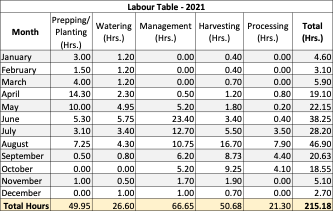
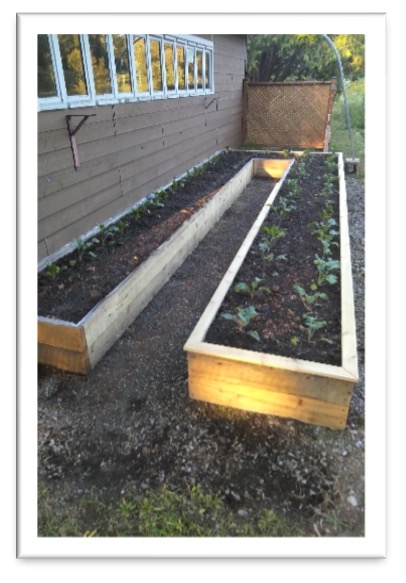
Looking at the table above, you can see that our total labour input for 2021 was 215.18 hours. Averaging that out for the year yields about 35 minutes/day. So, while I was off with my original ‘guesstimate’ of 15-20, I was still right about the dog thing. In other words, this amount of input is well within the realm of possibility for most people. Of course, that’s not quite a fair analysis because 80% of that time is spent in the 6 months between May and October. Nevertheless, even in our busiest month (August), labour still falls well short of a part-time job, with an average of about 45, non-consecutive minutes each day per person (2 adults). See the graphs below for a visual representation.
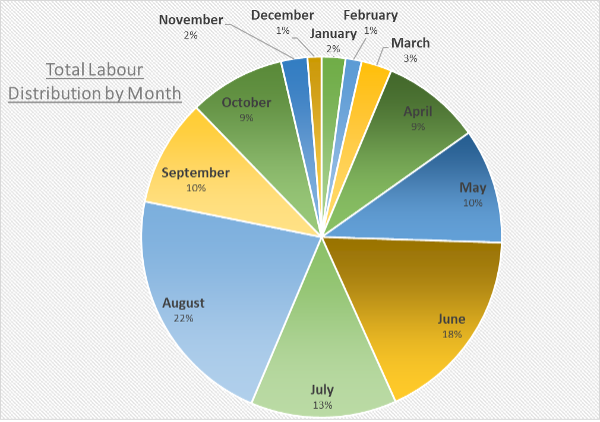
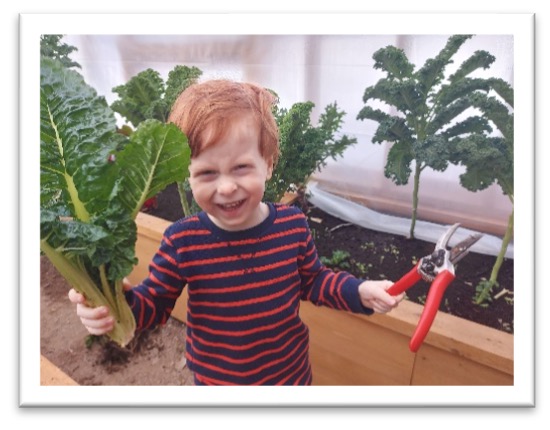
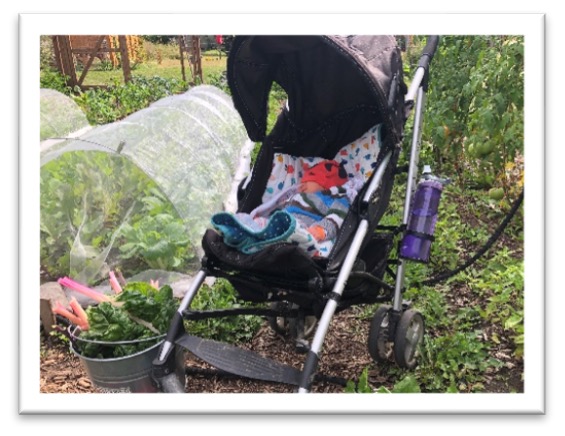
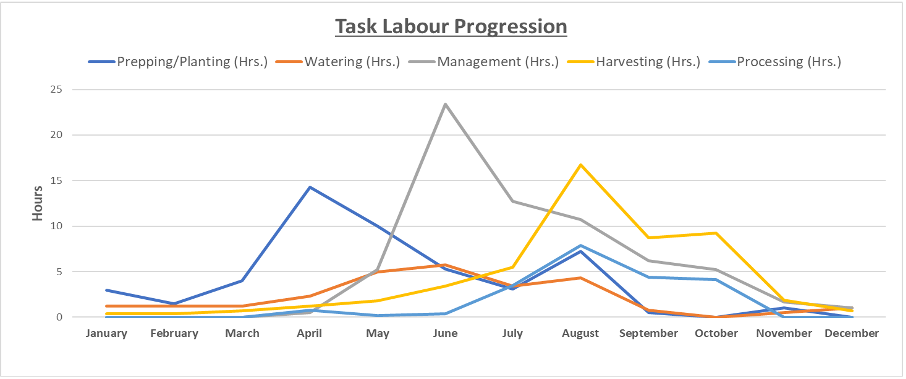
As far as value is concerned; we’ve always kept track of everything we grow. We do this first by measuring what we harvest, either in weight or volume, depending on the produce, then giving it an equivalent dollar value based on current market prices. For example, tomatoes are weighed in pounds, while kale and chard are counted in bunches. In 2021, local tomatoes were anywhere from $3/lb for bulk to more than $6/lb for heirlooms and cherries, while kale and chard bunches were around $3.50 each.
The only exceptions are things like peas and ground cherries that are typically sold in pints, and items we almost always harvest as a medley such as salad greens, as well as those that we pick only a little at a time, like parsley. While we do keep track of these to some degree, it’s impractical to assign them a truly accurate value for the season (“how many peas did we snack on again today in the garden…?”). See the table here for our 2021 harvest.
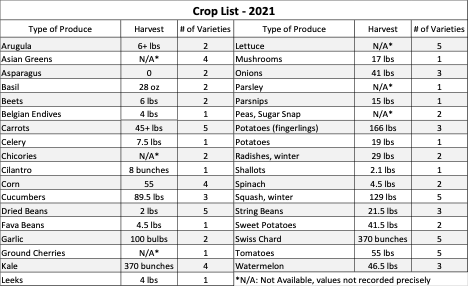
Using this system, we arrive at a total harvest value of about $6200 for 2021. Not a bad haul, for sure, but undersized compared to the $7200-$7500 we had forecasted. The year 2021 proved to be our most challenging yet, and while we were able to adjust and turn things around for most crops, others suffered irreparable setbacks. Most notable were our losses with tomatoes (100 lbs shy), winter squash (120 lbs short), and hardy greens (≈60 bunches shy). Nevertheless, the cycle continues and as we take our lessons to heart, we foster resiliency, build capacity, and hope for a better ‘next’ season, year after year.
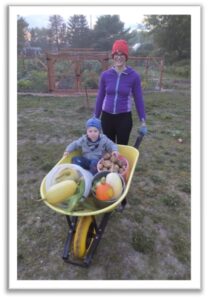
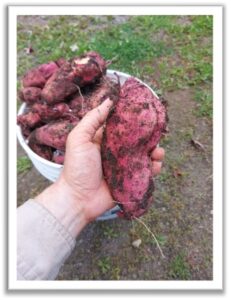
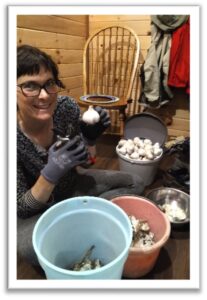
Here comes the math!
We have now reached the crux of the matter… the ‘juicy bit’, the ‘big reveal’, indeed, the ‘surprising twist’! You see, thanks to our little experiment and a few careful calculations, we’ve discovered that we’re actually saving a lot more money than we thought! While it may come as a surprise to many of you that growing one’s own food is more efficient than buying it (i.e., it takes less time and effort than ‘simply’ getting it from the store), any old-timer raised in the country or subsistence farmer can attest to that fact.
The economics of growing your own food have always been sound, but perhaps now more than ever… and getting sounder every year thanks to inflation. What surprised us was just how high our equivalent ‘wage’ really is. According to our data, in 2022 we will be ‘earning’ as much as $50/hr for our gardening efforts! Don’t believe me? Let’s have a closer look.
To illustrate my point, we need to compare two alternative scenarios: our current one, in which we grow all of our produce, and another by contrast, where we would purchase the exact same amount of produce instead. Both scenarios are based on our own data, and use real-world figures and estimates to complement, as needed. See the table below for the comparison, with calculations and explanations to follow.
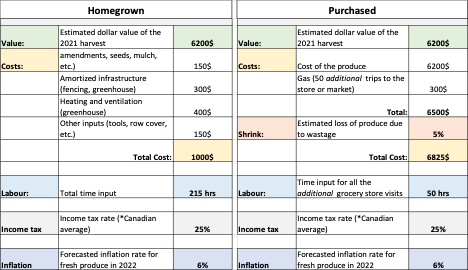
In both cases, the net value of the produce is the same, set at $6200 (our 2021 harvest). On one side, I’ve detailed our real-life approximate costs and labour components. On the other side, to the cost of the produce itself, I added a simple estimation of ‘labour’ and money spent to obtain the food based on time spent and cost of gas for the additional grocery store trips it would take us. We currently buy our other necessities at the rate of about once every 10 days. Should we also have to buy all of our produce, we reckon it would add at least another 50 trips/year to the store, at the estimated rate of 1 hr and $6 in gas per trip.
The numbers above are simple and simplistic, but they are real and concrete. And while the comparison isn’t perfect (as is indeed any complex hypothetical question), its value lies not in its precision, but in its illustration. The main point to appreciate is that in both scenarios there is a cost to obtaining the produce. In the first instance, the dollar cost is lower, but the labour cost is higher, and vice versa in the second instance.
One can choose to either ‘pay’ more, or ‘work’ more for their food. In other words, if we decided to stop gardening and switched to buying all of our produce, we would save some time, but that saved time would cost us money; we would be paying for those hours. The cost of each one of those hours is the real value or ‘wage’ earned when choosing to grow your own. It is a real-life savings. The exact number will vary from situation to situation of course, and many more factors will come into play, but the fact will always remain. See the equations below for the explanation in determining the value of each of those hours, based on the table above, and expressed as both a net and gross income equivalent.
The other important thing to note is that inflation works inversely in each case. On the one hand, inflation increases the value of your crops, while on the other it increases the cost of your purchases. With all things being equal, yearly inflation acts like a pay raise for the home growers, and as you will see in our example, it is not insignificant.
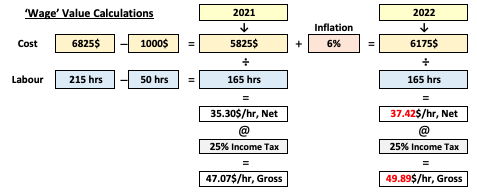
A note on ‘shrinkage’: The amount of food wasted in Canada, and elsewhere, borders on the unbelievable. The Food and Agriculture Organization estimates that 45% of all the fresh produce grown (fruits, vegetable, roots and tubers) is wasted, somewhere along the way. There are several avenues for this wastage, e.g., at the transit, storage, service industry, wholesale, retail, and consumer levels.
The one which concerns us most here is the consumer level, i.e., how much produce gets wasted after the consumer buys it. Again, there are several reasons why produce gets wasted: perhaps the quality was low to begin with, too much was purchased at one time, didn’t get eaten quickly enough before spoilage, leftovers were thrown out, etc. Think about how many times you’ve had to pick through tubs of salad greens, how many partial parsley bunches you’ve discarded, layers of cabbage or lettuce leaves peeled away, onion halves left to rot, and ‘forgotten’ veggies in the crisper. It all adds up.
There are inherent differences between ‘homegrown’ veggies and ‘purchased’ ones that all but guarantee that the former will suffer much less wastage. Most notably: when food comes from your garden, it is as fresh as can be and you can pick only what you need, when you need it, leaving none to go to waste. Also, you’re more likely to care about the food you’ve grown and less likely to waste it, in general.
Many reputable estimates exist for various aspects of food waste in Canada, but unfortunately, none exist for our specific little exercise. I settled on 5% as a realistic, conservative amount for household wastage, based on a higher proportion of fresh, local foods being purchased. For the sake of our equation, consider this analogy: If you wanted to have 100 apples, but knew you would lose 5, you’d have to purchase 105 to make up the difference. Therefore, it must be factored in as an increase to the net cost.
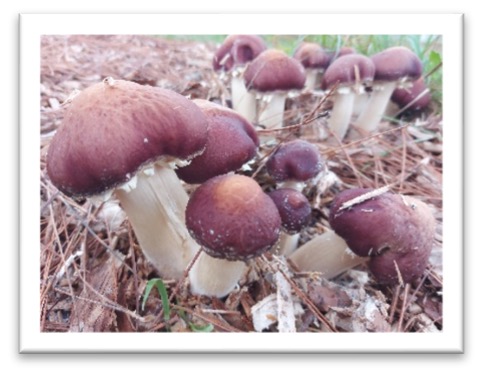


Afterthoughts
While there are many advantages, or benefits to growing your own food, financial motivations are usually low on the list. Things like freshness, taste, quality, variety, lifestyle and pleasure tend to predominate. Personally speaking, we have always also appreciated the constant learning experience that cultivation provides, the communion with nature, land stewardship and the opportunities for quality family time. Not to mention the everyday feelings of pride and satisfaction when you bring home a lovely harvest, and when your dinner meal is composed almost entirely of the fruits of your labour. No matter how nice the produce at the store or market is, I promise you it will never provide that same feeling. Sharing that same food with others only enhances it.
Over time, nurturing your garden also weaves itself into your life’s storybook; becomes an anchor, a reference point. Gardeners tend to keep at it their whole lives; it becomes second nature. Like other hobbies, gardening helps with the transition to retired life and keeps you active. It deepens your connection to a place; you are less likely to move away if you have an established garden. In the spirit of ‘like begets like’, I also believe that ‘caring begets caring’; taking care of your own natural space, fosters empathy for nature at large… but, I digress. This report is not a manifesto.
In 2021, we set out to establish a ‘baseline’ understanding of our total investment into this rewarding hobby. We gathered as much data as possible and played around with it. The results were fascinating (at least to us) and educational. We endeavoured to show that it was not only possible to have a subsistence garden in a cold climate, but that it was feasible for many. The space required is fairly small, and the time investment is manageable, even with kids and full-time jobs. Bonus benefit: it’s recession-proof and highly profitable! We’ve never really grown food for financial reasons, but it’s nice to see that our efforts are well rewarded regardless! We’ll add it to the long list of reasons why we keep doing it. If you don’t have a food garden yet, why not give it a try… it might grow on you!


